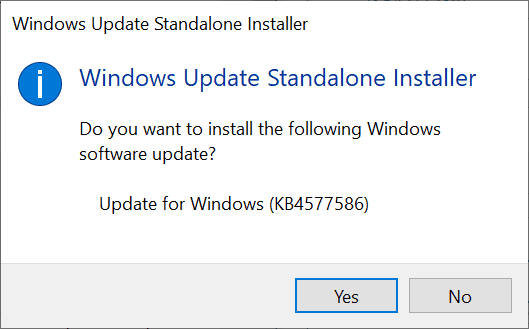Microsoft has released an optional update for Windows 10 and Windows 8.1 that will remove all traces of Adobe Flash Player from the operating systems when installed. Adobe Flash will be retired at the end of 2020 and companies like Microsoft, Google, and Mozilla have announced that they will drop support for the product in their browsers and systems.
KB4577586 will remove the native Flash Player installation on Windows 10 and 8.1 devices it is installed on. The update is only available on the Microsoft Update Catalog website and not via Windows Update, WSUS or other update management systems at the time of writing.
KB4577586, the Update for the removal of Adobe Flash Player, is released early by Microsoft to provide Microsoft customers with ample time to test the update and the removal of Flash Player on Windows systems.
Microsoft notes that Adobe Flash Player cannot be installed again once the update has been applied to a system. The only recourse after the installation of the update is to either reset the device to an earlier system restore point (prior to the installation of the Flash removing update), or to reinstall the entire Windows operating system.
Administrators can download the update from the Microsoft Update Catalog site. The update is made available for all supported operating system versions, and as such listed on two pages and in 38 different versions total. Major versions of Windows the Flash removing update is provided for are Windows 10 version 2004 and 20H2, Windows 10 version 1903 and 1909, Windows 10 version 1809, and Windows 8.1.
Select the download link next to the update version that you require to get started with the downloading and installation of the update. The Microsoft Update Catalog website opens a popup that contains the download link. Click on the download to download the update to the local system, and execute the downloaded file once it has been downloaded.

Windows Installer displays a confirmation prompt, and the selection of Yes proceeds with the update installation. The installation does not require a reboot, and Adobe Flash Player functionality should be removed from the system and Microsoft’s web browser. You can check the AppData/Roaming folder under the user directory to find out if the Macromedia folder is no longer there. Flash content won’t load anymore in Microsoft browsers once the update is installed.
Update: there appears to be some confusion regarding the update and the removal of Flash. The update removes Flash support in Internet Explorer and legacy Edge only, and not in the new Microsoft Edge browser. End
Note that the removal does not affect other browsers, e.g. Google Chrome, that may ship with Flash Player functionality.
The update will eventually be pushed via automatic updating systems such as Windows Update, as Flash Player won’t be supported after 2020 anymore.
(via Deskmodder)
